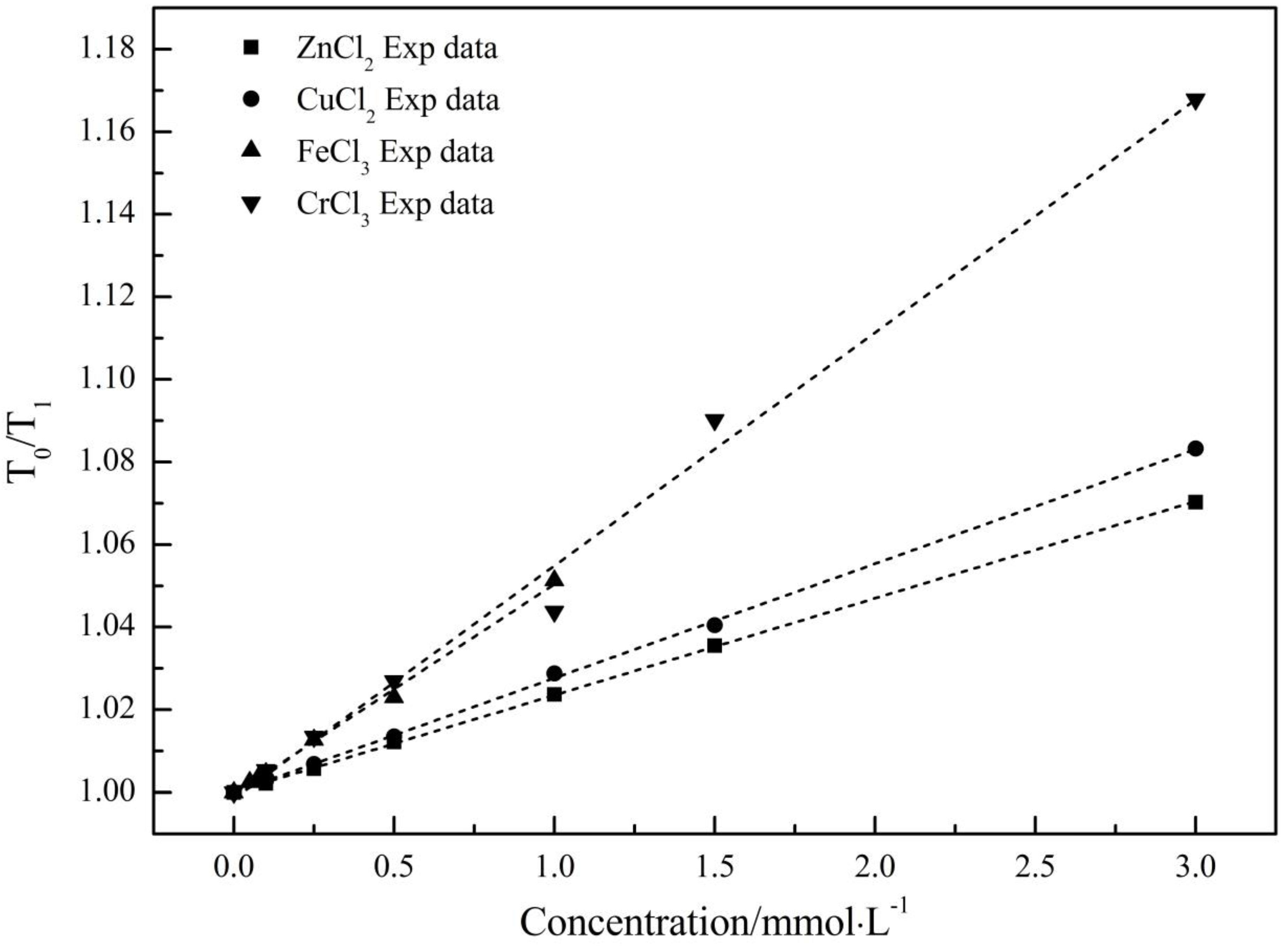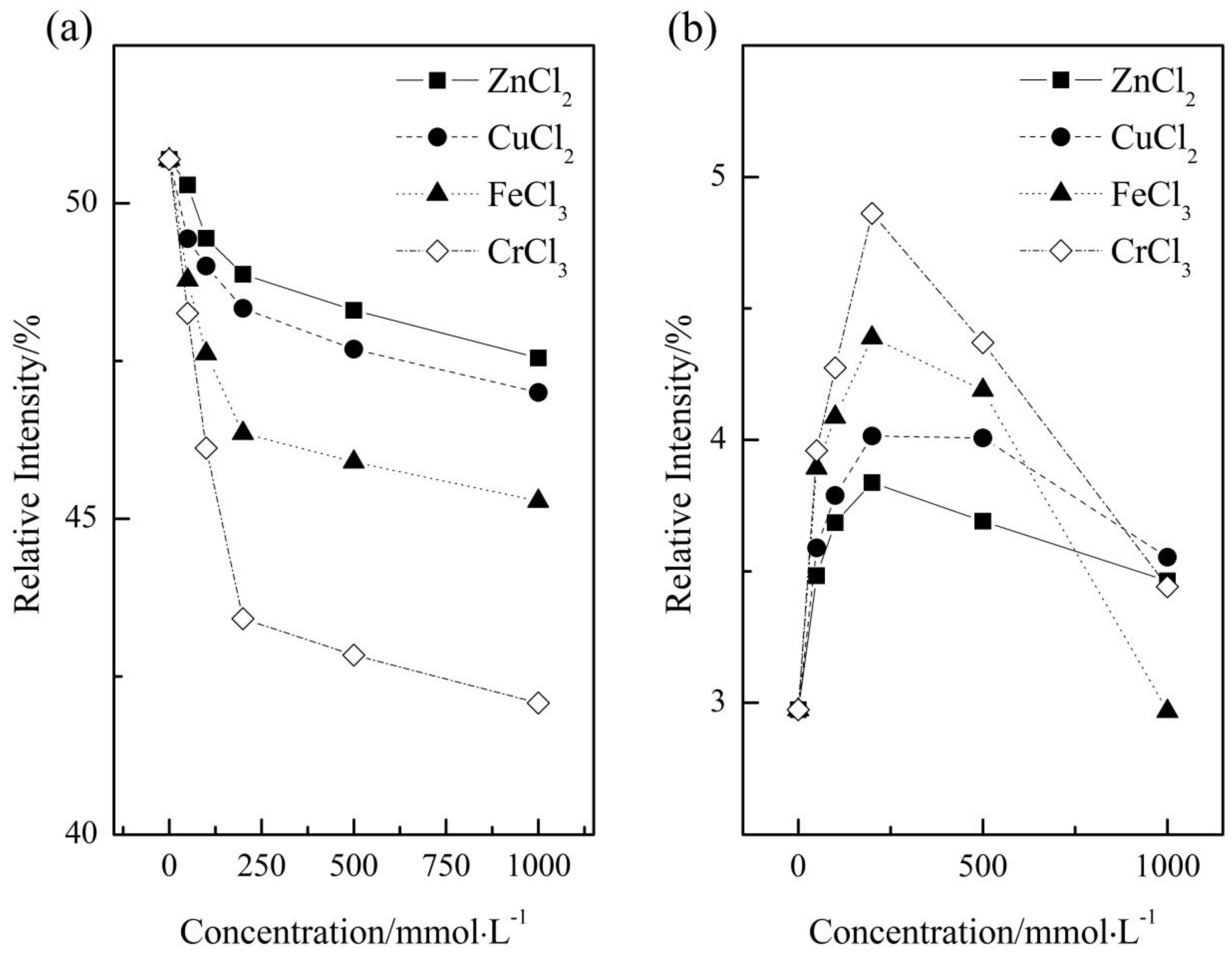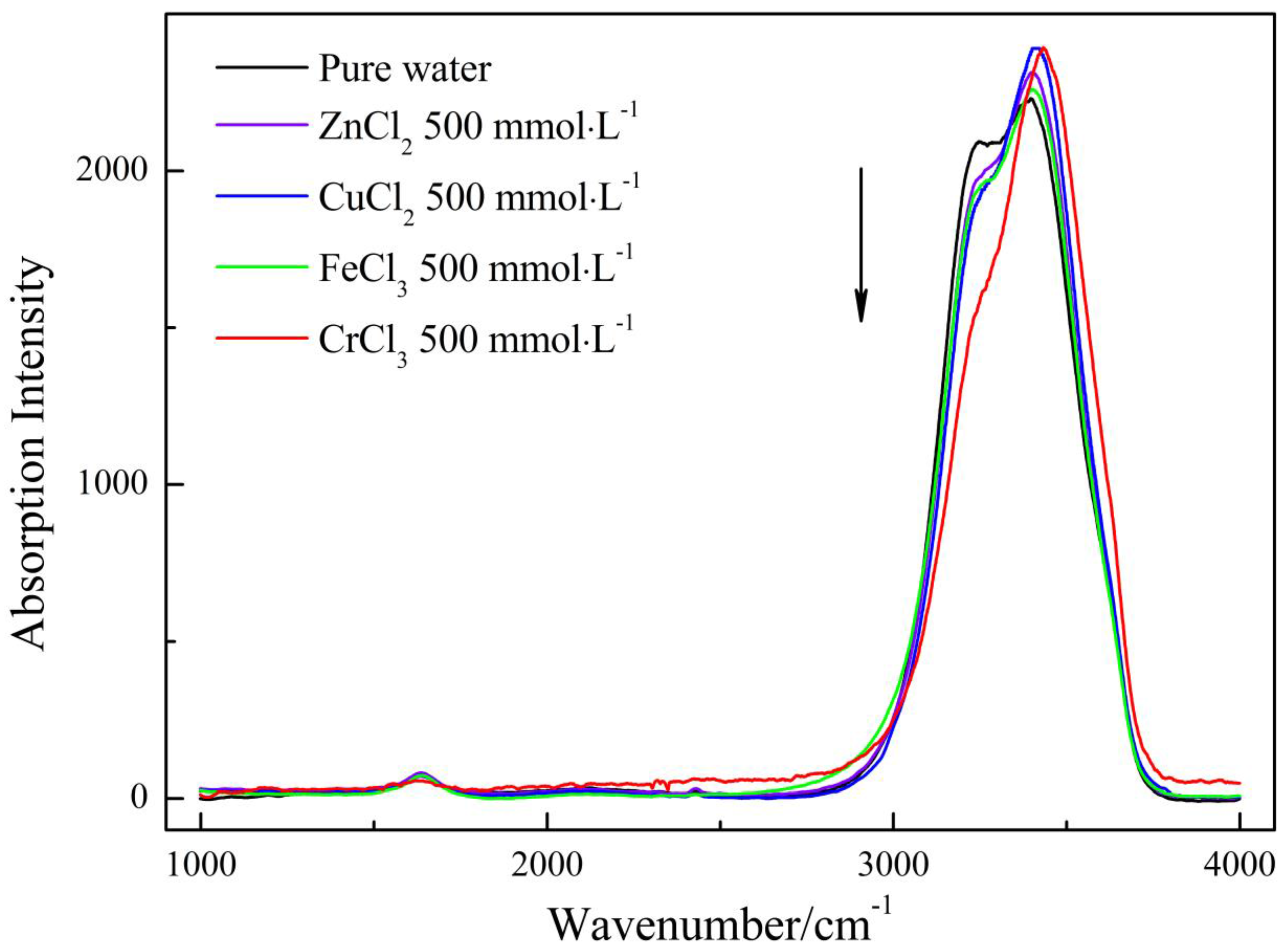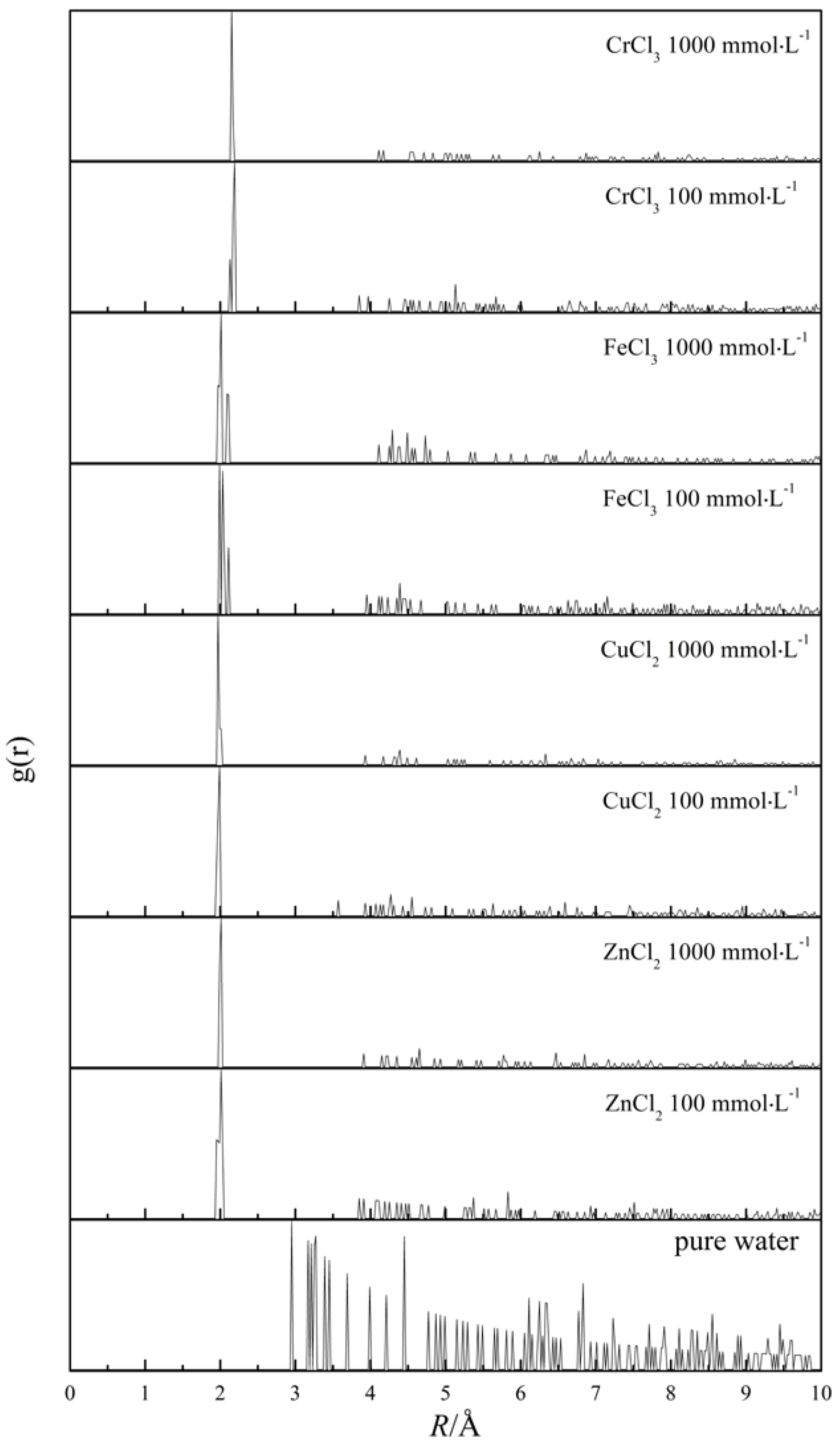The Opposite Effect of Metal Ions on Short-/Long-Range Water Structure: A Multiple Characterization Study
Abstract
:1. Introduction
2. Results
2.1. NMR Analysis
2.1.1. Spin-Lattice Relaxation Time (T1)
2.1.2. Diffusion Coefficient (D)
2.2. Viscosity Measurement
2.3. Raman Characterization
2.4. Molecular Dynamics Simulations
3. Discussion
4. Materials and Methods
4.1. Materials
4.2. NMR Measurements
4.3. Viscosity Measurements
4.4. Raman Characterization
4.5. Molecular Dynamics Simulations
5. Conclusions
Supplementary Materials
Acknowledgments
Author Contributions
Conflicts of Interest
Abbreviations
| MD | Molecular Dynamics |
| RDF | Radial Distribution Function |
| NMR | Nuclear Magnetic Resonance |
| DOSY | Diffusion-Ordered Spectroscopy |
| COMPASS | Condensed-Phase Optimized Molecular Potentials for Atomistic Simulation Studies |
| THz TDS | Terahertz Time-Domain Spectroscopy |
| EXAFS | Extended X-Ray Absorption Fine Structure |
References
- Zavitsas, A.A. Properties of water solutions of electrolytes and nonelectrolytes. J. Phys. Chem. B 2001, 105, 7805–7817. [Google Scholar] [CrossRef]
- Zavitsas, A.A. The nature of aqueous solutions: Insights into multiple facets of chemistry and biochemistry from freezing-point depressions. Chem. Eur. J. 2010, 16, 5942–5960. [Google Scholar] [CrossRef] [PubMed]
- McDonald, A.; Pushie, M.J.; Millhauser, G.L.; George, G.N. New insights into metal interactions with the prion protein: EXAFS analysis and structure calculations of copper binding to a single octarepeat from the prion protein. J. Phys. Chem. B 2013, 117, 13822–13841. [Google Scholar] [CrossRef] [PubMed]
- Eichhorn, G.L.; Shin, Y.A. Interaction of metal ions with polynucleotides and related compounds. XII. The relative effect of various metal ions on DNA helicity. J. Am. Chem. Soc. 1968, 90, 7323–7328. [Google Scholar] [CrossRef] [PubMed]
- Navarra, G.; Tinti, A.; Leone, M.; Militello, V.; Torreggiani, A. Influence of metal ions on thermal aggregation of bovine serum albumin: Aggregation kinetics and structural changes. J. Inorg. Biochem. 2009, 103, 1729–1738. [Google Scholar] [CrossRef] [PubMed]
- Paliwal, A.; Asthagiri, D.; Abras, D.; Lenhoff, A.; Paulaitis, M. Light-scattering studies of protein solutions: Role of hydration in weak protein-protein interactions. Biophys. J. 2005, 89, 1564–1573. [Google Scholar] [CrossRef] [PubMed]
- Kropman, M.F.; Bakker, H.J. Dynamics of water molecules in aqueous solvation shells. Science 2001, 291, 2118–2120. [Google Scholar] [CrossRef] [PubMed]
- Kropman, M.F.; Bakker, H.J. Effect of ions on the vibrational relaxation of liquid water. J. Am. Chem. Soc. 2004, 126, 9135–9141. [Google Scholar] [CrossRef] [PubMed]
- Omta, A.W.; Kropman, M.F.; Woutersen, S.; Bakker, H.J. Negligible effect of ions on the hydrogen-bond structure in liquid water. Science 2003, 301, 347–349. [Google Scholar] [CrossRef] [PubMed]
- Pestova, O.; Kostikov, Y.P.; Khripun, M. X-ray phase analysis of structure of water-salt systems: NaCl–H2O and KCl–H2O. Russ. J. Appl. Chem. 2004, 77, 1066–1069. [Google Scholar] [CrossRef]
- Badyal, Y.S.; Barnes, A.C.; Cuello, G.J.; Simonson, J.M. Understanding the effects of concentration on the solvation structure of Ca2+ in aqueous solution. II: Insights into longer range order from neutron diffraction isotope substitution. J. Phys. Chem. A 2004, 108, 11819–11827. [Google Scholar] [CrossRef]
- O’Brien, J.T.; Williams, E.R. Effects of ions on hydrogen-bonding water networks in large aqueous nanodrops. J. Am. Chem. Soc. 2012, 134, 10228–10236. [Google Scholar] [CrossRef] [PubMed]
- Samoilov, O.Y. A new approach to the study of hydration of ions in aqueous solutions. Discuss. Faraday Soc. 1957, 24, 141–146. [Google Scholar] [CrossRef]
- Lightstone, F.C.; Schwegler, E.; Hood, R.Q.; Gygi, F.; Galli, G. A first principles molecular dynamics simulation of the hydrated magnesium ion. Chem. Phys. Lett. 2001, 343, 549–555. [Google Scholar] [CrossRef]
- Li, R.H.; Jiang, Z.P.; Guan, Y.T.; Yang, H.W.; Liu, B. Effects of metal ion on the water structure studied by the Raman O–H stretching spectrum. J. Raman Spectrosc. 2009, 40, 1200–1204. [Google Scholar] [CrossRef]
- Paul, B.I.; Eugene, M.; Nickels, J.D.; Thuskolov, A.P. Influence of ions on water diffusion—A neutron scattering study. J. Phys. Chem. B 2013, 117, 7724–7728. [Google Scholar]
- Water Structure and Science. Available online: http://www1.lsbu.ac.uk/water/kosmotropes_chaotropes.html (accessed on 10 March 2015).
- Collins, K.D. Sticky ions in biological systems. Proc. Natl. Acad. Sci. USA 1995, 92, 5553–5557. [Google Scholar] [CrossRef] [PubMed]
- Suresh, S.; Kapoor, K.; Talwar, S.; Rastogi, A. Internal structure of water around cations. J. Mol. Liq. 2012, 174, 135–142. [Google Scholar] [CrossRef]
- Kondoh, M.; Ohshima, Y.; Tsubouchi, M. Ion effects on the structure of water studied by terahertz time-domain spectroscopy. Chem. Phys. Lett. 2014, 591, 317–322. [Google Scholar] [CrossRef]
- Engel, G.; Hertz, H.G. On the negative hydration. A nuclear magnetic relaxation study. Bunsen-Ges. Phys. Chem. Ber. 1968, 72, 808–834. [Google Scholar]
- Ben-Amotz, D.; Underwood, R. Unraveling water’s entropic mysteries: A unified view of nonpolar, polar, and ionic hydration. Acc. Chem. Res. 2008, 41, 957–967. [Google Scholar] [CrossRef] [PubMed]
- Jenkins, H.D.B.; Marcus, Y. Viscosity B-coefficients of ions in solution. Chem. Rev. 1995, 95, 2695–2724. [Google Scholar] [CrossRef]
- Antalek, B. Using pulsed gradient spin echo NMR for chemical mixture analysis: How to obtain optimum results. Concepts Magn. Reson. 2002, 14, 225–258. [Google Scholar] [CrossRef]
- Cohen, Y.; Avram, L.; Frish, L. Diffusion nmr spectroscopy in supramolecular and combinatorial chemistry: An old parameter—New insights. Angew. Chem. Int. Ed. 2005, 44, 520–554. [Google Scholar] [CrossRef] [PubMed]
- Garbacz, P.; Price, W.S. 1H NMR diffusion studies of water self-diffusion in supercooled aqueous sodium chloride solutions. J. Phys. Chem. A 2014, 118, 3307–3312. [Google Scholar] [CrossRef] [PubMed]
- Water Structure and Science. Available online: http://www1.lsbu.ac.uk/water/water_vibrational_spectrum.html (accessed on 10 March 2015).
- Deàk, J.C.; Rhea, S.T.; Iwaki, L.K.; Dlott, D.D. Vibrational energy relaxation and spectral diffusion in water and deuterated water. J. Phys. Chem. A 2000, 104, 4866–4875. [Google Scholar] [CrossRef]
- Max, J.J.; Chapados, C. Isotope effects in liquid water by infrared spectroscopy. III. H2O and D2O spectra from 6000 to 0 cm−1. J. Chem. Phys. 2009, 131. [Google Scholar] [CrossRef]
- Jones, G.; Dole, M. The viscosity of aqueous solutions of strong electrolytes with special reference to barium chloride. J. Am. Chem. Soc. 1929, 51, 2950–2964. [Google Scholar] [CrossRef]
- D’Angelo, P.; Barone, V.; Chillemi, G.; Sanna, N.; Meyer-Klaucke, W.; Pavel, N.V. Hydrogen and higher shell contributions in Zn2+, Ni2+, and Co2+ aqueous solutions: An X-ray absorption fine structure and molecular dynamics study. J. Am. Chem. Soc. 2002, 124, 1958–1967. [Google Scholar] [CrossRef] [PubMed]
- D’Angelo, P.; Benfatto, M. Effect of multielectronic configurations on the XAFS analysis at the Fe K edge. J. Phys. Chem. A 2004, 108, 4505–4514. [Google Scholar] [CrossRef]
- D’Angelo, P.; Bottari, E.; Festa, M.R.; Nolting, H.F.; Pavel, N.V. Structural investigation of copper (II) chloride solutions using X-ray absorption spectroscopy. J. Chem. Phys. 1997, 107, 2807–2812. [Google Scholar] [CrossRef]
- Lindqvist-Reis, P.; Muñoz-Páez, A.; Díaz-Moreno, S.; Pattanaik, S.; Persson, I.; Sandström, M. The structure of the hydrated gallium(III), indium(III), and chromium(III) ions in aqueous solution. A large angle X-ray scattering and EXAFS study. Inorg. Chem. 1998, 37, 6675–6683. [Google Scholar] [CrossRef] [PubMed]
- Einstein, A. Investigations on the Theory of the Brownian Movement; Dover Publications: New York, NY, USA, 1956. [Google Scholar]
- Smith, J.D.; Cappa, C.D.; Wilson, K.R.; Cohen, R.C.; Geissler, P.L.; Saykally, R.J. Unified description of temperature-dependent hydrogen-bond rearrangements in liquid water. Proc. Natl. Acad. Sci. USA 2005, 102, 14171–14174. [Google Scholar] [CrossRef] [PubMed]
- Sun, Q. Local statistical interpretation for water structure. Chem. Phys. Lett. 2013, 568–569, 90–94. [Google Scholar] [CrossRef]
- Fayer, M.D.; Moilanen, D.E.; Wong, D.; Rosenfeld, D.E.; Fenn, E.E.; Park, S. Water dynamics in salt solutions studied with ultrafast two-dimensional infrared (2D IR) vibrational echo spectroscopy. Acc. Chem. Res. 2009, 42, 1210–1219. [Google Scholar] [CrossRef] [PubMed]
- Raichlin, Y.; Millo, A.; Katzir, A. Investigations of the structure of water using mid-IR fiberoptic evanescent wave spectroscopy. Phys. Rev. Lett. 2004, 93. [Google Scholar] [CrossRef] [PubMed]
- Carey, D.M.; Korenowski, G.M. Measurement of the Raman spectrum of liquid water. J. Chem. Phys. 1998, 108, 2669–2675. [Google Scholar] [CrossRef]
- Chaplin, M. A proposal for the structuring of water. Biophys. Chem. 2000, 83, 211–221. [Google Scholar] [CrossRef]
- Odutola, J.A.; Dyke, T.R. Partially deuterated water dimers: Microwave spectra and structure. J. Chem. Phys. 1980, 72, 5062–5070. [Google Scholar] [CrossRef]
- Collins, K.D. Charge density-dependent strength of hydration and biological structure. Biophys. J. 1997, 72, 65–76. [Google Scholar] [CrossRef]
- Water Structure and Science. Available online: http://www1.lsbu.ac.uk/water/water_methods.html#vib (accessed on 10 March 2015).
- Savolainen, J.; Ahmed, S.; Hamm, P. Two-dimensional Raman-terahertz spectroscopy of water. Proc. Natl. Acad. Sci. USA 2013, 110, 20402–20407. [Google Scholar] [CrossRef] [PubMed]
- Fecko, C.; Eaves, J.; Loparo, J.; Tokmakoff, A.; Geissler, P. Ultrafast hydrogen-bond dynamics in the infrared spectroscopy of water. Science 2003, 301, 1698–1702. [Google Scholar] [CrossRef] [PubMed]
- Lock, A.J.; Woutersen, S.; Bakker, H.J. Ultrafast energy equilibration in hydrogen-bonded liquids. J. Phys. Chem. A 2001, 105, 1238–1243. [Google Scholar] [CrossRef]
- Cowan, M.; Bruner, B.D.; Huse, N.; Dwyer, J.; Chugh, B.; Nibbering, E.; Elsaesser, T.; Miller, R. Ultrafast memory loss and energy redistribution in the hydrogen bond network of liquid H2O. Nature 2005, 434, 199–202. [Google Scholar] [CrossRef] [PubMed]
- Shiraga, K.; Suzuki, T.; Kondo, N.; De Baerdemaeker, J.; Ogawa, Y. Quantitative characterization of hydration state and destructuring effect of monosaccharides and disaccharides on water hydrogen bond network. Carbohydr. Res. 2015, 406, 46–54. [Google Scholar] [CrossRef] [PubMed]
- Nicodemus, R.A.; Ramasesha, K.; Roberts, S.T.; Tokmakoff, A. Hydrogen bond rearrangements in water probed with temperature-dependent 2D IR. J. Phys. Chem. Lett. 2010, 1, 1068–1072. [Google Scholar] [CrossRef]
- Zhao, L.; Ma, K.; Yang, Z. Changes of water hydrogen bond network with different externalities. Int. J. Mol. Sci. 2015, 16, 8454–8489. [Google Scholar] [CrossRef] [PubMed]
- Shannon, R.D.T. Revised effective ionic radii and systematic studies of interatomic distances in halides and chalcogenides. Acta Crystallogr. Sect. A Cryst. Phys. Differ. Theor. Gen. Crystallogr. 1976, 32, 751–767. [Google Scholar] [CrossRef]
- Bloembergen, N. Proton relaxation times in paramagnetic solutions. J. Chem. Phys. 1957, 27, 572–573. [Google Scholar] [CrossRef]







| System | Bvis (L·mmol−1) | T | R2 |
|---|---|---|---|
| ZnCl2 | 3.3790 × 10−4 | 1.0125 | 0.9946 |
| CuCl2 | 4.1319 × 10−4 | 1.0014 | 0.9994 |
| FeCl3 | 6.2041 × 10−4 | 0.9964 | 0.9974 |
| CrCl3 | 8.9294 × 10−4 | 0.9935 | 0.9946 |
© 2016 by the authors; licensee MDPI, Basel, Switzerland. This article is an open access article distributed under the terms and conditions of the Creative Commons Attribution (CC-BY) license (http://creativecommons.org/licenses/by/4.0/).
Share and Cite
Ma, K.; Zhao, L. The Opposite Effect of Metal Ions on Short-/Long-Range Water Structure: A Multiple Characterization Study. Int. J. Mol. Sci. 2016, 17, 602. https://doi.org/10.3390/ijms17050602
Ma K, Zhao L. The Opposite Effect of Metal Ions on Short-/Long-Range Water Structure: A Multiple Characterization Study. International Journal of Molecular Sciences. 2016; 17(5):602. https://doi.org/10.3390/ijms17050602
Chicago/Turabian StyleMa, Kai, and Lin Zhao. 2016. "The Opposite Effect of Metal Ions on Short-/Long-Range Water Structure: A Multiple Characterization Study" International Journal of Molecular Sciences 17, no. 5: 602. https://doi.org/10.3390/ijms17050602
APA StyleMa, K., & Zhao, L. (2016). The Opposite Effect of Metal Ions on Short-/Long-Range Water Structure: A Multiple Characterization Study. International Journal of Molecular Sciences, 17(5), 602. https://doi.org/10.3390/ijms17050602





